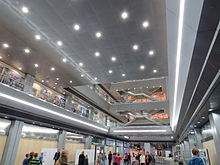National Library of Latvia
The current building was designed in 1989 by noted Latvian-American architect Gunnar Birkerts (1925–2017), who immigrated to the United States and made his career there.
Today, the Library plays an important role in the development of Latvia's information society, providing Internet access to residents and supporting research and lifelong education.
[1] Its first chief librarian and bibliographer was Jānis Misiņš (1862–1944), who made his immense private collection the basis of the new library.
After the war, while Latvia was under Soviet rule, the institution was known as State Library of the Latvian SSR (Latvijas PSR Valsts bibliotēka).
The massive union catalogue Seniespiedumi latviešu valodā (Ancient Prints in Latvian 1525–1855, published in Riga, 1999)[7] received the Spīdola Prize in 2000 and was awarded The Beautiful Book of the Year 99.
[8] In 2005, the Letonikas grāmatu autoru rādītājs (1523-1919) (Index of the Authors of Lettonica Books (1523–1919)) was published,[9] providing information about versatile branches of science and representatives of various nations, Latvia being the main focus of their publications.
The NLL includes several collections of posters (artists Oskars Šteinbergs (1882–1937), Sigismunds Vidbergs (1890–1970), Raoul Dufy (1877–1953), Bernhard Borchert (1863–1945), Niklāvs Strunke (1894–1966) and others).
[12] The first discussions about the need for a new National Library began as early as 1928, and the significance of the project of this century was confirmed by high-level international recognition of the value of its collections.
[14] Furthermore, since 1996, some holdings of rarely used books had to be stored in a repository in Silakrogs [lv] outside the capital, in a former Soviet missile bunker.
[17] In 2008, construction started according to the design of noted Latvian-American architect Gunnar Birkerts, who had been based in the Detroit, Michigan area since the early 1950s.
As part of Riga's programme for its title as European Capital of Culture, selected holdings were symbolically carried from the old to the new building by a human chain on 18 January 2014.
Among others, it hosted the 4th summit of the EU's Eastern Partnership programme in May 2015,[24] and a debate chaired by the BBC's Jonathan Dimbleby on 14 March 2016.



